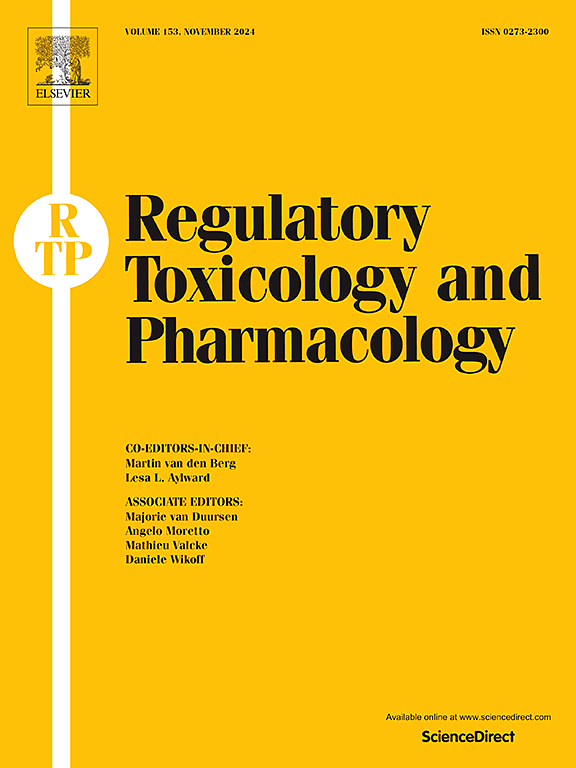New artificial neural network models for risk assessment of skin sensitization using amino acid derivative assay, KeratinoSens™, human cell line activation test and in silico structural alert parameter
IF 3.5
4区 医学
Q1 MEDICINE, LEGAL
引用次数: 0
Abstract
In the next-generation risk assessment (NGRA) of skin sensitization, estimating the point of departure (PoD) is crucial. The murine local lymph node assay (LLNA) has been considered the ‘gold standard’ for evaluating the skin sensitizing potential of chemicals, with the LLNA EC3 values serving as the PoD for dermal quantitative risk assessment (QRA). This study presents artificial neural network (ANN) models that predict EC3 values, enhanced by integrating the Amino Acid Derivative Reactivity Assay (ADRA) to expand the applicability domain. Initially, descriptors derived from ADRA, based on both molar and gravimetric concentrations, showed significant correlations with LLNA EC3 values. We then constructed prediction models using ANN analysis, incorporating parameters from GL497-adopted methods. These models exhibited a strong correlation with LLNA EC3 values. The predicted EC3 values for molar and gravimetric concentrations correlated well with each other and with previous values from an ANN model using DPRA instead of ADRA. Additionally, the prediction accuracy of ANN models combined with “2 out of 3″ negative judgment for GHS classification was comparable to that of ITSv1/v2. Ultimately, this enables QRA for a broader range of substances using predictive EC3 values as PoDs without animal testing, paving the way for more effective risk assessments.
使用氨基酸衍生物试验、KeratinoSens™、人类细胞系激活试验和硅结构警报参数进行皮肤致敏风险评估的新人工神经网络模型。
在下一代皮肤致敏风险评估(NGRA)中,起始点(PoD)的估计是至关重要的。小鼠局部淋巴结测定(LLNA)被认为是评估化学物质皮肤致敏潜力的“金标准”,LLNA EC3值作为皮肤定量风险评估(QRA)的PoD。本研究提出了预测EC3值的人工神经网络(ANN)模型,并通过集成氨基酸衍生物反应性测定(ADRA)来增强模型的适用性。最初,基于摩尔浓度和重量浓度的ADRA描述符显示出与LLNA EC3值的显著相关性。然后,我们使用人工神经网络分析构建预测模型,纳入gl497采用的方法的参数。这些模型与LLNA EC3值有很强的相关性。摩尔浓度和重量浓度的预测EC3值相互之间以及与使用DPRA而不是ADRA的ANN模型的先前值具有良好的相关性。此外,ANN模型结合“2 / 3”否定判断对GHS分类的预测精度与ITSv1/v2相当。最终,这使得QRA能够使用预测EC3值作为pod而无需动物试验,从而为更有效的风险评估铺平道路。
本文章由计算机程序翻译,如有差异,请以英文原文为准。
求助全文
约1分钟内获得全文
求助全文
来源期刊
CiteScore
6.70
自引率
8.80%
发文量
147
审稿时长
58 days
期刊介绍:
Regulatory Toxicology and Pharmacology publishes peer reviewed articles that involve the generation, evaluation, and interpretation of experimental animal and human data that are of direct importance and relevance for regulatory authorities with respect to toxicological and pharmacological regulations in society. All peer-reviewed articles that are published should be devoted to improve the protection of human health and environment. Reviews and discussions are welcomed that address legal and/or regulatory decisions with respect to risk assessment and management of toxicological and pharmacological compounds on a scientific basis. It addresses an international readership of scientists, risk assessors and managers, and other professionals active in the field of human and environmental health.
Types of peer-reviewed articles published:
-Original research articles of relevance for regulatory aspects covering aspects including, but not limited to:
1.Factors influencing human sensitivity
2.Exposure science related to risk assessment
3.Alternative toxicological test methods
4.Frameworks for evaluation and integration of data in regulatory evaluations
5.Harmonization across regulatory agencies
6.Read-across methods and evaluations
-Contemporary Reviews on policy related Research issues
-Letters to the Editor
-Guest Editorials (by Invitation)

 求助内容:
求助内容: 应助结果提醒方式:
应助结果提醒方式:


